Ford Madox Brown's Drawings for King Lear
While in Paris in 1843-4, Ford Madox Brown sketched a set of eighteen pen-and-ink studies for King Lear. Two designs he later developed as finished paintings--Lear and Cordelia (1848-49) and Cordelia's Portion (1866)--and a third he turned into an oil-sketch, Cordelia Parting from Her Sisters (1854). Sixteen of the drawings were shown in 1865 at his Picadilly Exhibition, and Brown wrote the captions that appear below the drawings for the exhibition catalog. The sixteen sketches with captions are owned by the Whitworth Gallery in Manchester, and the two without captions are in the City Museum and Art Gallery of Birmingham. The drawings are done in pen and sepia ink over pencil on paper; they are approximately 11 x 14 inches in size.
The idea of a series such as this was not original with Brown; the German artist Moritz Retzsch had completed his series of outlines of Shakespeare's plays (1828-46), which included a series on King Lear, and Eugène Delacroix had published his series of thirteen lithographs for Hamlet in 1843, a year before Brown executed his drawings. Critics think Brown knew the work of both artists and was influenced by them.
Brown regarded these sketches as no more than "outlines," writing in the catalogue that accompanied his 1865 retrospective exhibition that they "were never intended but as rude first ideas for future more finished designs" (19). Despite their unfinished quality, they powerfully evoke what Lucy Rabin describes as a "vaguely remote historical period" (52), a time represented by Shakespeare as post-Roman but still pre-Christian. Ford Madox Hueffer, the painter's grandson, suggests that the crudity of the sketches was, in fact, deliberate--Brown's attempt to portray in bold, almost flat designs the barbarity of Lear and the era in which he lived (53).
Brown reveals in these simple depictions an understanding of King Lear that far surpasses anything the critics had to say about a play that was not at all popular in the nineteenth century. Charles Lamb observed early in the century that "Lear is essentially impossible to be represented on a stage," and at the end of the century--as in, for example, a review of Sir Henry Irving's King Lear at the Lyceum Theatre--the critics were still quoting Lamb and asserting that King Lear "would not be tolerated for an hour if produced without the name of Shakspere" (Illustrated London News 101:637). Small wonder that Sir Henry Irving was reportedly nervous and anxious when he produced this unpopular play at the Lyceum in 1892.
With just a few bold lines Brown captures the psychology of the characters, as well as Lear's physical decay and gradual descent into madness; the artist was by now "fully in command of the means to represent individual facial expression and he used his knowledge lavishly to depict transient emotional interaction between the figures," Lucy Rabin says. "The calculated ugliness," she continues, "gives the series an intensely human quality which possesses a moral force of its own. And the crude forms give the whole work a stunning directness unknown to European historical painting of the time. The personalities in Brown's representation of Lear are an exuberantly alive as today's news photography, though we know for other reasons that they are figures from the distant past" (53-4).
In the first picture Lear leans forward on his throne and menacingly glares at Cordelia as he awaits her answer; she can only stand silently with her palms out as if pleading with the belligerent old man. In the second picture Lear slumps back in his seat, glowering with anger, disappointment--perhaps even disbelief--as Cordelia buries her face in her hand and leans on France for support. And so it goes until the last sketches when Lear dances crazily with his fool and then finally lies stricken on his pallet while Cordelia reaches out to him in tenderness. The paintings based on the second and last of the drawings reveal how deeply Brown was affected by Lear's history of mistrust, misunderstanding, and violent betrayal. Lucy Rabin notes how these eighteen drawings constitute an almost cinematographic scenario (51); the series does indeed look much like what a director would call the "story-board" for a film script.
Brown's drawings for King Lear are thoroughly discussed by Helen O. Borowitz ("'King Lear' in the Art of Ford Madox Brown"), Lucy Rabin (Ford Madox Brown and the Pre-Raphaelite History-Picture, 51-60), and Martin Meisel (Realizations 419-26). The reproductions below are from Meisel, pp. 422-4, and Rabin, illustrations 18-35.
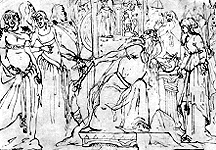
[1] Cordelia is asked to state the measure of her love. . . . She answers, "Nothing, my Lord." Lear says, "Nothing! speak again, for out of nothing nothing comes," I,1.
|
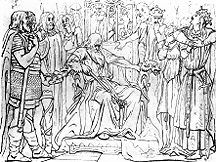
[2] Here Cordelia, disinherited, is chosen in marriage by the king of France . . . ,I,1.
|
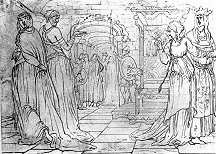
[3] The parting of Cordelia and her sisters, I,1.
|
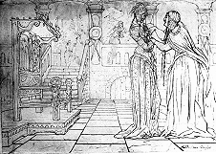
[4] Regan and Goneril compare notes, I,1.
|
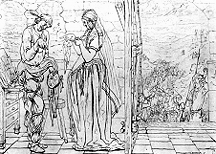
[5] . . . Goneril, in the absence of her father at the chase, instigates her steward to be less respectful to him, I,3.
|

[6] Lear, returned from hunting hungry, calls the steward, who passes on with a "So please you, my Lord," I,4.
|

[7] King Lear rates the steward, who answers slightingly, I,4.
|

[8] The Duke of Kent . . . trips up the steward, I,4.
|
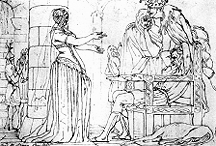
[9] Goneril violently rates her father--Kent sorrowfully looks on, and the Fool rails at her, I,4.
|
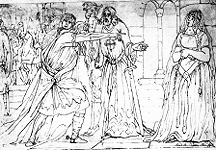
[10] King Lear incensed leaves Goneril's house, her husband in vain seeking to interpose, I,4.
|

[11] The Duke of Kent tries to pick a quarrel with Goneril's steward, II,2.
|
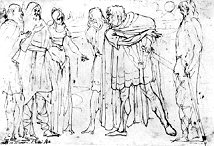
[12] II,2.
|
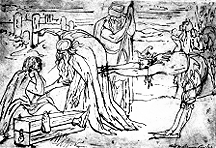
[13] King Lear will not believe that his own daughter, Regan, would have his messenger, Kent, placed in the stocks, II,4.
|
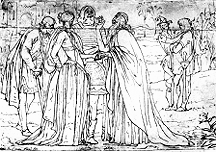
[14] King Lear gives the history of his wrongs to Regan and her husband in the presence of the Duke of Gloucester, II,4.
|
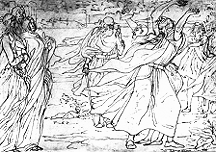
[15] Lear . . . curses and goes off in the rising storm, shelterless, II,4.
|

[16] King Lear with his Fool in the storm, III,2.
|
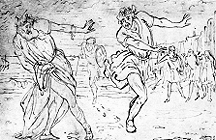
[17] King Lear mad on the beach at Dover, IV,6.
|
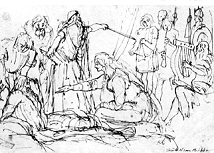
[18] IV,7.
|

















